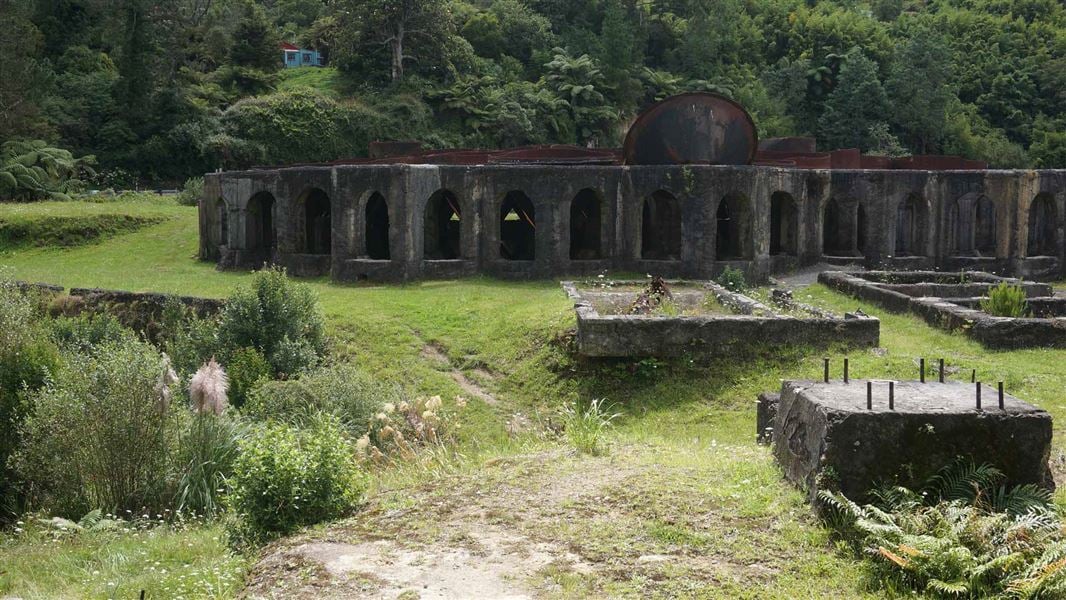Temporary car park closure
Victoria Battery carpark will be closed on weekdays from 7 am to 7 pm to allow contractors to carry out upgrade works on Waitawheta Road. During this period, alternative parking for access is available at the Waikino car park.
The expected reopening date is Friday 19 December 2025.
Built from 1897 – 1898, the site of the Victoria Battery occupies an extensive flat within a big bend of the Ohinemuri River opposite Waikino village.
Most structures were removed or demolished after the battery ceased operations in 1952 but substantial concrete and masonry walls and footings remain on the site. Most significant are the clustered bases of the cyanide tank complex, the huge in-ground ore roasting kilns and their access tunnels, and the transformer house - a large concrete building now used as the site-museum.
On adjacent private land there is a high embankment that once supported the incline tramway up which the ore trucks were winched to the roasting kilns.
History
After the Waihi Goldmining Company acquired the Martha mine at Waihi in 1891, new reefs were discovered so regularly that it almost seemed as though there was no end to the payable ore. The company’s two plants in Waihi could not cope and it was decided to build a massive new battery complex at Waikino.
Construction started in 1897 and ore crushing began the following year. During its 54 years of operation the plant was continually modified and improved until it closed in 1952. (Waikato Register, p.61). The ore from the mine was conveyed to the battery by an 8km tramway known as ‘the rakeline’.
Fabric significance
Despite the removal of most of the plant and buildings, the remaining original fabric on the expansive battery site, in conjunction with innovative interpretation, has tremendous potential to tell the story behind one of New Zealand’s greatest goldmining operations and a company which, in its day, was a household name.
To the significant features outlined above can be added a growing number of visitor amenities which are designed to enhance or help interpret the original structural remains. These include a tramway operated by the Victoria Battery Tramway Society with taped commentary, the Mayclair mining machinery collection, a site-museum in the former powerhouse, underground kiln tours, and an overhead gantry above the ore kilns which are covered with a huge protective roof structure which is a replica of the original roof.
Historic significance
During the first half of the twentieth century the Victoria battery was one of the foremost industrial sites in New Zealand. It was an integral part of the Waihi GMC’s Martha mining operation. With 200 head of stamps it was by far the largest gold ore crushing battery in New Zealand – the next in size had only 60 head.
The Waihi GMC introduced many technological innovations on the site including the use of electric power from its own dam on the Waikato (the first on the river), and the development of tube mills and refined cyaniding technology to maximise gold recovery. It employed 800 men in three shifts for much of its existence and was the reason the nearby township of Waikino was established.
Victoria Battery, Waikino factsheet with map (PDF, 380K)
Getting there
Victoria Battery is located off SH2, between Paeroa and Waihi.
Head west from Waihi on SH2, turn left into Waitewheta road, then turn left after the bridge at Karangahake Gorge Historic Walkway into the road access for Victoria Battery. This is road is frequented by cyclist and walkers.
Parking is available in the rest bay off SH2 adjacent to the Waikino Hotel and opposite to the Waikino Railway station. Access is available by foot or cycle over the foot bridge.
Facilities
There pathways, interpretation signs and a museum on the site. It will take about an hour to visit the site, and longer if visiting the museum.
